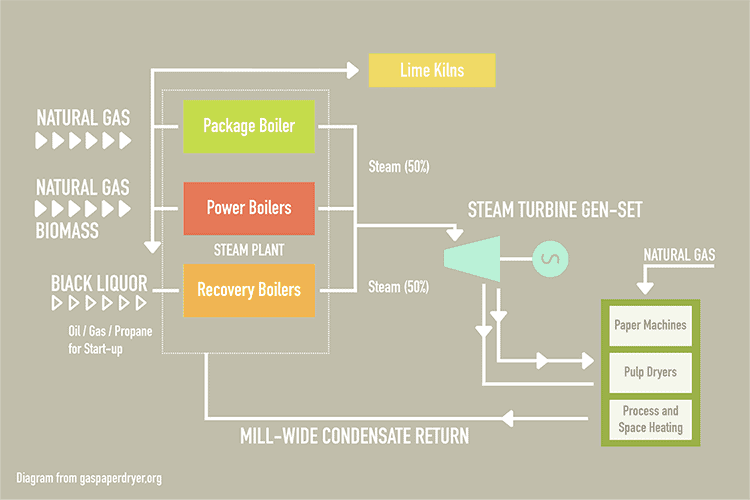Within the paper manufacturing industry, there are four main energy consumers: conventional boilers, CHP/ cogeneration, process heating and drivepower. Below, we break down how these four energy consumers are used.

The Process
Manufacturing paper is a process that’s very energy intensive. The pulping process (the cooking of wood chips to open the fibers that create paper materials) uses about 1/2 of the total energy required. There are two types of mills and both have differing energy requirements. An ‘integrated’ mill includes pulping and paper manufacturing, and uses twice as much energy as a mill of the same size that brings in ‘market pulp.’ Market pulp is pulp that’s brought in from another location and sold as a raw material.
1. Conventional Boilers
Boilers are extremely important to the paper manufacturing process, the diagram below shows the major thermal energy flow process of a conventional integrated mill.

Boilers used in paper manufacturing are typically gas or oil. Power House boilers generally use coal, wood waste, black liquor, oil, natural gas, or a combination of fuels. The type of fuel used depends on the size of the mill and whether there’s a pulping operation on site. Many mills have multiple different kinds of boilers on site and most include steam turbines to generate electricity. Like the other manufacturing industries in this series, the boilers produce high pressure steam. In this process, much of the steam is used by the steam turbine to generate the electricity that runs the mill.
2. CHP / Cogeneration
Combined Heat and Power (CHP) involves using wasted heat in conventional power plants to generate electricity. Paper manufacturers that use CHP plants can reach efficiencies of over 80%, in comparison to coal and gas plants that at best, operate at around 40% efficiency. Boosted efficiency in CHP plants reduces overall energy costs.
Many paper mills harness waste biomass produced during the pulping process to generate electricity. Although carbon dioxide is still produced by CHP, it’s significantly less than other processes and contributes to reducing emissions.
3. Process Heating
Process heating is extremely versatile, which is what makes it so integral to the paper manufacturing process. A process heater can accommodate many different materials, including: air, ammonia, petrochemicals, fuel oils or gases, water, or nitrogen.
It is integral to the paper manufacturing industry as it plays a crucial role in ensuring quality and consistency. Dryers and kilns used for biomass drying require heating in the safest, most reliable way possible. Similarly, plants typically use tank & suction heating, plant utility heating, and indirect steam generators, which also require heat.
The heating of calendar rolls is an extremely important aspect that requires process heating to control pressure, temperature and dwell time. The danger of using alternative heaters to immersion heaters (process heaters) is that temperature can erratically fluctuate throughout the process, which ruins the quality of the paper.
4. Drivepower
Drivepower refers to the power being used to run systems such as motors, hydraulics, etc. It converts electrical or hydraulic power into mechanical motion (typically rotary) to drive systems that process paper.
Within the paper industry, drivepower is often required for the machinery used to create the end paper product. Some of the ways drive power can be used include supporting machines for: coatedpaper, printinggrades, finepapers, tissue and sanitary paper, linerboard and fiber board, uncoated board and bleached board, newsprint and phone book paper, corrugated medium and paper pulp and kraft.
Drivepower totals almost a third of all energy consumption within the industry and is integral to paper manufacturing. Systems typically use a paper machine with AC and DC drives. However, as technology advances, there is opportunity to integrate a line shaft conversion, which removes the need for a DC drive. Shifting to non conventional direct drive systems can help companies to realize significant energy savings by simplifying the mechanics and offering operators enhanced control of equipment.






